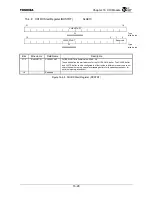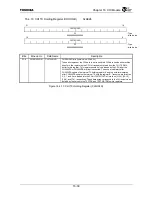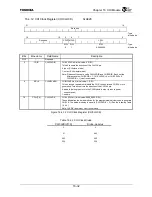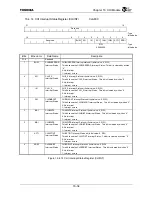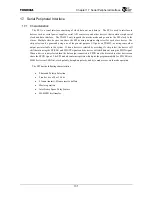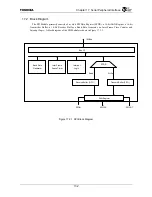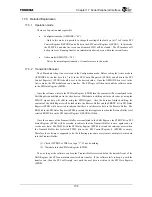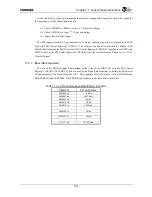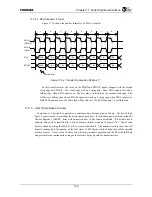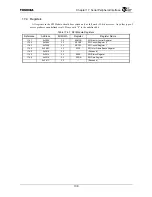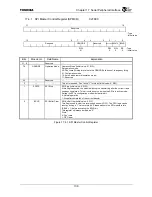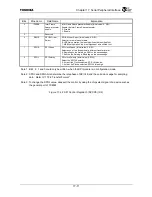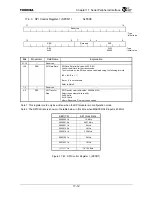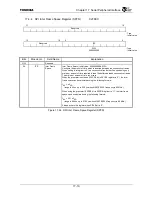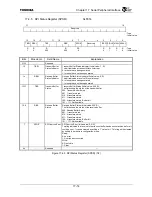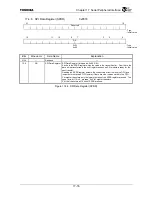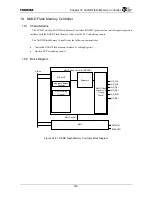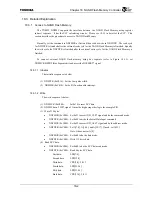
Chapter 17 Serial Peripheral Interface
17-3
17.3 Detailed
Explanation
17.3.1 Operation
mode
There are 2 operation modes possible:
•
Configuration mode (OPMODE = ‘01’) :
Only in this mode it is possible to change the setting of the low byte (bit 7 to 0) in the SPI
Control Register 0 (SPCR0) and all bits in the SPI Control Register 1 (SPCR1). In this mode
the SPSTP bit and also the receive and transmit FIFO will be cleared. The SPI module will
be kept in reset. Running transfer are immediately aborted, even within the current frame.
•
Active mode (OPMODE = ‘10’) :
This is the normal operation mode. A transfer occurs in this mode.
17.3.2 Transmitter/Receiver
The SPI module is kept in a reset state in the Configuration mode. Before setting the Active mode in
OPMODE bits, the low byte (bit 7 to 0) in the SPI Control Register 0 (SPCR0) and all bits in the SPI
Control Register 1 (SPCR1) should be set to the desired value. Once the OPMODE bits is set to the
Active mode, the SPI module can run a transfer. The SPI logic will then wait until the software writes
to the SPI Data Register (SPDR).
Once the software writes to the SPI Data Register (SPDR) then the contents will be transferred to the
Shift Register and shifted out to the slave device. While data is shifting out to the slave device using the
SPIOUT signal, data will shift in using the SPIIN signal. Once the data has finished shifting, the
contents of the Shift Register will be loaded into the Receive Buffer and the SRRDY bit in SPI Status
Register (SPSR) will be asserted to indicate that there is valid receive data in the Receive Buffer. The
RBSI bit in the SPI Status Register (SPSR) is set and the interrupt occurs when the Receive Buffer level
selected RXIFL bits in the SPI Control Register 0 (SPCR0) is filled.
Once the contents of the Transmit Buffer are transferred to the Shift Register, the STRDY bit in SPI
Status Register (SPSR) will be asserted to indicate that the Transmit Buffer is once again ready to
receive new data. The TBSI bit in the SPI Status Register (SPSR) is set and the interrupt occurs when
the Transmit Buffer level selected TXIFL bits in the SPI Control Register 0 (SPCR0) is empty.
Therefore the software is supposed to do the following procedure every time it attempts to write data
into the Transmit Buffer.
(1) Check if STRDY or TBSI is a logic “1”. If not, do nothing.
(2) Write data into the SPI Data Register (SPDR).
Thus, as long as the software can keep the Transmit Buffer serviced before the data shifts out of the
Shift Register, the SPI can maintain seamless data transfer. If the software fails to keep up with the
transfer rate, then the SPI will simply wait until the next data is written to the SPI Data Register
(SPDR).
Содержание TMPR4925
Страница 1: ...64 Bit TX System RISC TX49 Family TMPR4925 Rev 3 0 ...
Страница 4: ......
Страница 15: ...Handling Precautions ...
Страница 16: ......
Страница 18: ...1 Using Toshiba Semiconductors Safely 1 2 ...
Страница 40: ...3 General Safety Precautions and Usage Considerations 3 18 ...
Страница 42: ...4 Precautions and Usage Considerations 4 2 ...
Страница 43: ...TMPR4925 ...
Страница 44: ......
Страница 54: ...Chapter 1 Features 1 8 ...
Страница 58: ...Chapter 2 Block Diagram 2 4 ...
Страница 88: ...Chapter 4 Address Mapping 4 12 ...
Страница 226: ...Chapter 8 DMA Controller 8 58 ...
Страница 260: ...Chapter 9 SDRAM Controller 9 34 ...
Страница 480: ...Chapter 15 Interrupt Controller 15 32 ...
Страница 554: ...Chapter 19 Real Time Clock RTC 19 8 ...
Страница 555: ...Chapter 20 Removed 20 1 20 Removed ...
Страница 556: ...Chapter 20 Removed 20 2 ...
Страница 564: ...Chapter 21 Extended EJTAG Interface 21 8 ...
Страница 580: ...Chapter 22 Electrical Characteristics 22 16 ...
Страница 586: ...Chapter 23 Pin Layout Package 23 6 23 2 Package Package Type Package Code 256 pin PBGA PBGA 4L P BGA256 2727 1 27A4 ...
Страница 588: ...Chapter 24 Usage Notes 24 2 ...
Страница 590: ...Appendix A TX49 H2 Core Supplement A 2 ...






